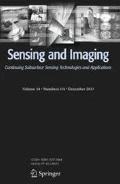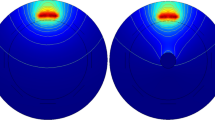Abstract
Electromagnetic tomography (EMT) is an emerging imaging modality capable of visualizing the distribution of electrically conductive or magnetically permeable materials within the vessels and pipelines. Image reconstruction is the crucial step of EMT inverse problem, which is one of the main challenges in the promotion and application of EMT to industrial and biomedical fields. EMT inverse problem is ill-posed and ill-conditioned, which is the key to the reconstructed images quality. Tikhonov regularization is the widely used regularization method to solve the ill-posed problem. The revised Tikhonov regularization is obtained by improving the Tikhonov regularization when observation noise is considered. This paper presents an improved conjugate gradient algorithm based on the revised Tikhonov regularization to reduce the ill-posed nature of EMT inverse problem and enhance the spatial resolution of the reconstructed images. Numerical simulations results confirm that the quality of the reconstructed images obtained by the proposed algorithm is improved and also better than the other conventional algorithms including linear back projection, Tikhonov regularization algorithm, Landweber iterative algorithm, in terms of the typical patterns. Besides, correlation coefficients of the proposed ICGRT algorithm are 0.5961, 0.5989 and 0.5231 for three experimental typical patterns. The proposed ICGRT algorithm has highest correlation coefficients and reconstructs the best images.







Similar content being viewed by others
References
Peyton, A. J., Yu, Z. Z., Lyon, G., Al-Zeibak, S., Ferreira, J., Velez, J., Linhares, F., Borges, A. R., Xiong, H. L., Saunders, N. H., & Beck, M. S. (1996). An overview of electromagnetic inductance tomography: Description of three different systems. Measurement Science Technology, 7, 261–271. https://doi.org/10.1088/0957-0233/7/3/006
Ma, L., & Soleimani, M. (2017). Magnetic induction tomography methods and applications: A review. Measurement Science and Technology, 28, 1–12. https://doi.org/10.1088/1361-6501/aa7107
Muttakin, I., Wondrak, T., & Soleimani, M. (2020). Magnetic induction tomography sensors for quantitative visualization of liquid metal flow shape. IEEE Sensors Letters, 4(7), 6001204. https://doi.org/10.1109/lsens.2020.3000292
Soleimani, M., Li, F., Spagnul, S., Palacios, J., Barbero, J. I., Gutierrez, T., & Viotto, A. (2020). In situ steel solidification imaging in continuous casting using magnetic induction tomography. Measurement Science and Technology, 31, 065401. https://doi.org/10.1088/1361-6501/ab6f30
Yin, W., & Peyton, A. J. (2006). A planar EMT system for the detection of faults on thin metallic plates. Measurement Science and Technology, 17, 2130–2135. https://doi.org/10.1088/0957-0233/17/8/011
Yin, W., Chen, G., Chen, L., & Wang, B. (2011). The design of a digital magnetic induction tomography (MIT) system for metallic object imaging based on half cycle demodulation. IEEE Sensors Journal, 11, 2233–2240. https://doi.org/10.1109/jsen.2011.2128866
Ma, L., & Soleimani, M. (2014). Hidden defect identification in carbon fibre reinforced polymer plates using magnetic induction tomography. Measurement Science and Technology, 25, 055404. https://doi.org/10.1088/0957-0233/25/5/055404
Liu, Z., Li, W., Xue, F., Xiafang, J., Bu, B., & Yi, Z. (2015). Electromagnetic tomography rail defect inspection. IEEE Transactions on Magnetics, 51, 1–7. https://doi.org/10.1109/tmag.2015.2430283
Wang, C., He, H., Cui, Z., Cao, Q., Zou, P., & Wang, H. (2018). A novel EMT system based on TMR sensors for reconstruction of permeability distribution. Measurement Science and Technology, 29, 104008. https://doi.org/10.1088/1361-6501/aad8ea
Li, F., Soleimani, M., & Abascal, J. (2019). Planar array magnetic induction tomography further improvement. Sensor Review, 39(2), 257–268. https://doi.org/10.1108/sr-02-2018-0027
Cui, Z., Chen, Y., & Wang, H. (2019). A dual-modality integrated sensor for electrical capacitance tomography and electromagnetic tomography. IEEE Sensors Journal, 19(21), 10016–10026. https://doi.org/10.1109/jsen.2019.2927629
Xiao, Z., Tan, C., & Dong, F. (2019). 3-D hemorrhage imaging by cambered magnetic induction tomography. IEEE Transactions on Instrumentation and Measurement, 68(7), 2460–2468. https://doi.org/10.1109/tim.2019.2900779
Chen, Y., Tan, C., & Dong, F. (2021). Combined planar magnetic induction tomography for local detection of intracranial hemorrhage. IEEE Transactions on Instrumentation and Measurement, 70, 4500111. https://doi.org/10.1109/tim.2020.3011621
Xiang, J., Dong, Y., & Yang, Y. (2020). Multi-frequency electromagnetic tomography for acute stroke detection using frequency-constrained sparse bayesian learning. IEEE Transactions on medical imaging, 39(12), 4102–4112. https://doi.org/10.1109/tmi.2020.3013100
Bakhsheshi, M. F., Ho, M., Keenliside, L., & Lee, T. Y. (2019). Non-invasive monitoring of brain temperature during rapid selective brain cooling by zero-heat-flux thermometry. Emerging Science Journal, 3(1), 1–9. https://doi.org/10.28991/esj-2019-01163
Han, M., Cheng, X., & Xue, Y. (2016). Comparison with reconstruction algorithms in magnetic induction tomography. Physiological Measurement, 37, 683–697. https://doi.org/10.1088/0967-3334/37/5/683
Cui, Z., Wang, Q., Xue, Q., Fan, W., Zhang, L., Cao, Z., Sun, B., Wang, H., & Yang, W. (2016). A review on image reconstruction algorithms for electrical capacitance/resistance tomography. Sensor Review, 36, 429–445. https://doi.org/10.1108/sr-01-2016-0027
Xiao, J., Liu, Z., Zhao, P., Li, Y., & Huo, J. (2018). Deep learning image reconstruction simulation for electromagnetic tomography. IEEE Sensors Journal, 18(8), 3290–3298. https://doi.org/10.1109/jsen.2018.2809485
Liu, X., Liu, Z., Li, Y., Zhao, P., & Wang, J. (2020). Research on direct 3D electromagnetic tomography technique. IEEE Sensors Journal, 20(9), 4758–4767. https://doi.org/10.1109/jsen.2020.2966274
Zhaba, V., & Gohman, E. (2020). Activation level and probabilities of electromagnetic γ-transitions in the reaction 77Se(γ,γ’)77mSe. Emerging Science Journal, 4(3), 165–171. https://doi.org/10.28991/esj-2020-01220
Prenga, D. (2020). General features of the q-XY opinion model. Journal of Human, Earth, and Future, 1(2), 87–96. https://doi.org/10.28991/hef-2020-01-02-05
Ghorbani, R., & Nahvi, M. (2019). Analysis of performance of howland AC current source for electrical impedance spectro-tomography. Sensing and Imaging, 20, 28. https://doi.org/10.1007/s11220-019-0251-1
Liu, X., & Liu, Z. (2019). A novel algorithm based on L1-Lp norm for inverse problem of electromagnetic tomography. Flow Measurement and Instrumentation, 65, 318–326. https://doi.org/10.1016/j.flowmeasinst.2019.01.010
Liu, Z., He, M., & Xiong, H. (2005). Simulation study of the sensing field in electromagnetic tomography for two-phase flow measurement. Flow Measurement and Instrumentation, 16, 199–204. https://doi.org/10.1016/j.flowmeasinst.2005.02.008
Li, F., Abascal, J., Desco, M., & Soleimani, M. (2017). Total variation regularization with split bregman-based method in magnetic induction tomography using experimental data. IEEE Sensors Journal, 17, 976–985. https://doi.org/10.1109/jsen.2016.2637411
Wang, Q., Li, K., Zhang, R., Wang, J., Sun, Y., Li, X., Duan, X., & Wang, H. (2019). Sparse defects detection and 3D imaging base on electromagnetic tomography and total variation algorithm. Review of Scientific Instruments, 90, 124703. https://doi.org/10.1063/1.5120118
Yuan, G., & Hu, W. (2018). A conjugate gradient algorithm for large-scale unconstrained optimization problems and nonlinear equations. Journal of Inequalities and Applications, 2018(1), 113. https://doi.org/10.1186/s13660-018-1703-1
Zhu, Z., Ma, J., & Zhang, B. (2020). A new conjugate gradient hard thresholding pursuit algorithm for sparse signal recovery. Computational and Applied Mathematics, 39(4), 270. https://doi.org/10.1007/s40314-020-01313-5
Acknowledgements
The work is supported by Scientific and technological research project in Henan Province (No. 212102210620) and Doctoral Research Fund (No. 2020BSJJ006).
Author information
Authors and Affiliations
Corresponding author
Additional information
Publisher's Note
Springer Nature remains neutral with regard to jurisdictional claims in published maps and institutional affiliations.
Rights and permissions
About this article
Cite this article
Liu, X., Wang, Y. An Improved Conjugate Gradient Image Reconstruction Algorithm for Electromagnetic Tomography. Sens Imaging 23, 5 (2022). https://doi.org/10.1007/s11220-021-00374-y
Received:
Revised:
Accepted:
Published:
DOI: https://doi.org/10.1007/s11220-021-00374-y




